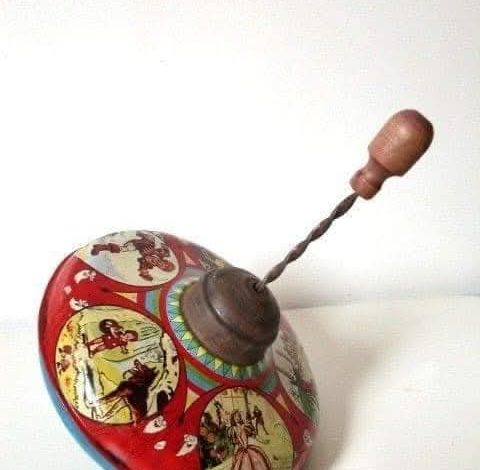The Timeless Charm of the Vintage Spinning Top

ADVERTISEMENT
The Timeless Charm of the Vintage Spinning Top
Introduction
Before the age of video games and electronic toys, simple, hand-powered playthings ruled the world of childhood entertainment. Among these, the spinning top holds a special place, captivating generations with its simplicity and elegance. The vintage spinning top depicted in the image is not merely a toy—it’s a piece of history, a symbol of craftsmanship, and a source of joy for children and adults alike. This article explores the origins, significance, and enduring charm of the spinning top, celebrating its role as a timeless plaything.
The History of the Spinning Top
The spinning top is one of the oldest toys known to humanity, with origins dating back to ancient civilizations. Archaeological discoveries have unearthed tops made of wood, clay, and stone from ancient Egypt, Greece, and Rome. These early tops were often used for both entertainment and rituals, as their spinning motion was associated with cosmic forces and the passage of time.
By the 19th and early 20th centuries, spinning tops had evolved into intricately designed toys, often made from tin or metal and painted with vibrant colors. The vintage spinning top shown in the image reflects this era of craftsmanship, with detailed illustrations that add an artistic touch to its functionality.
Design and Mechanism
The vintage spinning top is a marvel of simple engineering. Its sturdy metal body ensures durability, while its colorful surface, adorned with illustrations of dancing couples and scenes of joy, adds a sense of whimsy. The top operates by twisting the handle, which sets the internal mechanism in motion, allowing the top to spin gracefully.
ADVERTISEMENT
This mechanism not only made the top easy to use but also added a tactile, interactive element to playtime. The sound of the top whirring as it spun, combined with the mesmerizing motion, created an engaging and almost hypnotic experience for children.
Cultural Significance
The spinning top transcends borders and cultures, with variations of the toy appearing in nearly every corner of the globe. From the Japanese “koma” to the Indian “lattu,” the top has been a universal symbol of play and creativity.
In many cultures, spinning tops were more than just toys; they were tools for social bonding. Children would gather to compete, seeing whose top could spin the longest or perform tricks. The top also became a symbol of skill and precision, as mastering the art of spinning required practice and coordination.
The vintage spinning top in the image, with its detailed design and nostalgic charm, represents an era when toys were made with care and attention to detail, reflecting the values of a simpler time.
A Nostalgic Treasure
For many, the spinning top evokes fond memories of childhood—a time of innocence, wonder, and unbridled imagination. The vintage top, with its vibrant illustrations and timeless design, serves as a bridge to the past, reminding us of the joy found in simple pleasures.
ADVERTISEMENT
Collectors and enthusiasts today treasure these vintage tops as artifacts of a bygone era. They see them not only as toys but also as works of art and craftsmanship, preserving a piece of history that continues to inspire and delight.
Conclusion
The vintage spinning top is more than just a toy; it’s a testament to the enduring appeal of simple, well-crafted playthings. Its history, design, and cultural significance make it a cherished item that connects us to the past while reminding us of the timeless joy of play.
As we look back on toys like the spinning top, we are reminded of the importance of imagination, creativity, and the simple pleasures that shape our lives. Whether as a collector’s item or a source of nostalgia, the vintage spinning top continues to spin its magic, captivating hearts across generations.
Title: The Timeless Charm of the Vintage Spinning Top
ADVERTISEMENT




